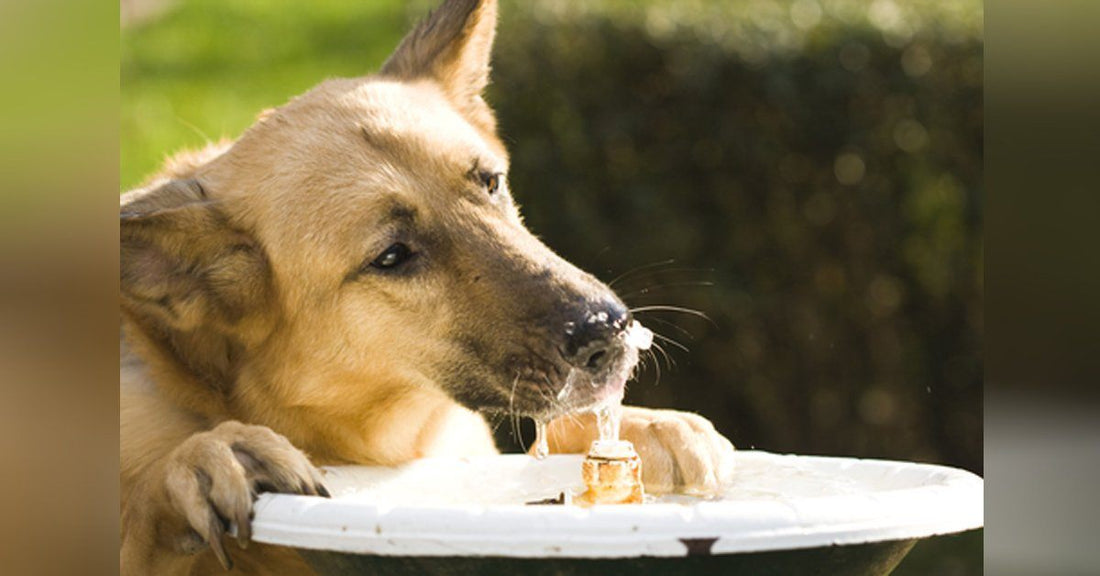Water-Is your Dog Getting Enough?

Making sure your dog has a balanced healthy diet includes ensuring that he gets all the fresh water his body needs to run properly, as well as healthy nutritious food.
Water makes up 70% of an adult dogs’ weight and 84% of a puppies. An inadequate supply of fresh water daily can lead to serious illness and dehydration. Water is essential for every living cell and every vital function of the body and without the proper amount of fluid each day your dog’s body will quickly break down, leading to damage of his vital organs.
What does water do for my dog?
Water carries nutrients in and out of all the cells in your dog’s body
Helps your dog absorb the nutrients he needs.
Aids digestion
Cools the body temperature
Maintains a normal body temperature
Lubricates all the joints
Cushions vital organs and internal tissue
Removes waste through urine and bowel movements
How much water does a dog need daily?
According to Mark Stickney, DVM, Clinical Associate Professor at Texas A & M’s College of Veterinary Medicine & Biomedical Sciences in College Station:
“To stay properly hydrated, healthy adult dogs should drink about one ounce of water per pound of body weight.”
A healthy dog with plenty water available to him will generally drink enough to keep himself well hydrated. However, there are several factors that affect the amount of water your dog may need. Such as:
The amount of exercise he gets
The weather outside
Inside temperature
The type of food he eats
A dog that eats kibble will need more water than a dog that eats raw or canned foods that contain moisture.
Generally, a dog will need about an ounce of water per pound of body weight each day but under certain conditions may need as much as 3 ounces per pound of body weight due to diet, medications or health conditions.
A hydration calculator is a great tool and there is one available online at: http://troffpouch.com/hydration-calculator/
How to Encourage your Dog to Drink More Water
Provide fresh clean water daily and refill your dog’s water bowl frequently.
Purchase extra bowls to place around the house and yard.
Dogs like fresh running water so consider the purchase of a pet water fountain that filters water.
If your dog is notorious for knocking over his dish, you may want to purchase a weighted water bowl that is harder to knock over.
Bring extra water when taking your dog out for exercise or when traveling.
Freeze low sodium broth in ice cube trays and use them for treats.
Add ice cubes to water.
Add moisture to your dog’s food.
Reasons for adding moisture to your dog’s diet:
Unlike canned foods which contain 70 to 80% water dry kibble contains as little as 5 to 10 percent moisture, if your dog eats dry kibble daily add water or low sodium broth to his kibble to increase his fluid intake.
Chronically ill dogs suffering from Cushing’s disease and other metabolic disorders, kidney and liver disease, cancer, diabetes and pregnant or nursing dogs become dehydrated easily and need more water.
Dogs who are ill with fever, infection, inflammation, vomiting or diarrhea will have increased thirst and need more water.
Certain medications that your dog may be taking can cause increased thirst: drugs for heart failure, asthma, allergies, fluid retention, anti-inflammatory drugs, and medications for inflammatory bowel disease and seizure disorders can all increase your dog’s thirst and need for more water.
Table foods that contain salt will contribute to excessive thirst and too much salt can be toxic to dogs. Excessive salt can cause tremors, diarrhea, vomiting and depression, so it’s best to keep all salty foods away from your dog.
Is my dog dehydrated?
Some dogs suffering from illness have a higher risk of becoming dehydrated so if you’re concerned that your dog might be dehydrated check your dog for these symptoms of dehydration:
Pick up a fold of skin on top of his shoulder blades and pull gently up and release it. A well hydrated dog will have skin that falls back into place quickly. A dehydrated dog will have skin that stays up and then slowly falls into place.
Other symptoms include: pale gums, dry mouth, sticky or rope like saliva, dry nose, sunken eye balls?
If you think your dog may be dehydrated or notice any extreme changes in your dog’s water intake, make an immediate appointment with your veterinarian.
























